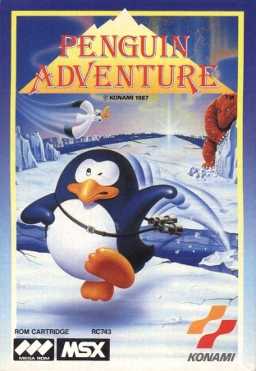Penguin Adventure
| Penguin Adventure | |
|---|---|
 European box art | |
| Developer(s) | Konami Zemina (SMS Only) |
| Publisher(s) | Konami Zemina (SMS Only) |
| Designer(s) | Ryouhei Shogaki Hideo Kojima |
| Composer(s) | Yoshinori Sasaki Kenichi Matsubara |
| Platform(s) | MSX, Sega Master System, Mobile phones, Virtual Console, Microsoft Windows |
| Release date(s) | MSX Master System
|
| Genre(s) | Platform game Action-adventure game |
| Mode(s) | Single player Multiplayer (alternating) |
Penguin Adventure (夢大陸アドベンチャー Yume Tairiku adobenchā, lit. "Dream Continent Adventure") is an action-adventure platform video game released by Konami in 1986. It is a sequel to Antarctic Adventure and has the distinction of being the first game that game designer Hideo Kojima worked on;[2] he was an assistant designer. It has been acclaimed as one of the best MSX action games for its gameplay, depth, variety and rich pseudo-3D tile-based graphics with sprites. The story follows Penta, a penguin who has to bring home a golden apple in order to cure Penguette (Penko Hime in the Japanese version), the Penguin Princess.
Gameplay
This title significantly expanded upon the gameplay of Antarctic Adventure by most notably adding a greater variety of stages and enemies and RPG elements: boss fights, purchasable items, and several mini-games. Items can be purchased through three different fisherman, in exchange for fish, that give Penta new abilities. One of the items that can be bought is a gun, which reflects the charactization Pentarou (Penta's son) will be given in his appearances in the Parodius series. Level design and variety has increased from Antarctic Adventure; there are forest levels, ice levels, water-based levels, caves, and even an outer-space bonus level.[3] There are several shortcuts, usually hidden underneath holes (which are typically harmful hazards) in the game, that allow the player to go on almost completely different paths. The game also featured multiple endings, with the hidden good ending available when the player pauses the game a certain number of times.[4] In the bad ending, the princess dies, while in the good ending, she lives, an idea that Kojima would later use again in Metal Gear Solid and, to an extent, Metal Gear Solid 2: Sons of Liberty.[5]
Ports
- The Sega Master System Version was released on Korea, and Developed and Published by Zemina on 1987.
- The MSX Version was re-released for Compilation of Sony PlayStation and Sega Saturn Konami's Antiques MSX Collection.
- An Mobile Version was released on May 31, 2006 in Japan.
- A MSX Version was re-released for Wii Virtual Console on November 24, 2009 in Japan.
- A MSX Version was re-released for Wii U Virtual Console on January 29, 2014 in Japan.
- A MSX Version was re-released for PC (as Project EGG) on April 11, 2014 in Japan.
Other Media
| Penguin Adventure: Penta no daibōken Korokorokokoro no Penko-hime | |
| 夢大陸アドベンチャー -ペン太の大冒険 コロコロココロのペン子姫- (Yume Tairiku Adobenchā: Penta no daibōken Korokorokokoro no Penko-hime) | |
|---|---|
| Manga | |
| Published by | Konami Digital Entertainment |
| Magazine | Weekly Konami Magazine |
| Published | September 15, 2009 - February 2, 2007 |
| Volumes | 20 |
In 2006, Konami Digital Entertainment Tokyo serialize a series of digital comic based on video game of same name titled Yume Tairiku Adobenchā: Penta no daibōken Korokorokokoro no Penko-hime (夢大陸アドベンチャー -ペン太の大冒険 コロコロココロのペン子姫- lit. "Dream Continent Adventure: Penta's Adventure, Penguette's Colosse Heart").[6]
References
- ↑ "夢大陸アドベンチャー (PC)". Konami. Retrieved 2015-01-26.
- ↑ KONAMIのMSX往年の名作がWiiバーチャルコンソールに登場 (Translation), Famitsu
- ↑ Penguin Adventure at MobyGames
- ↑ Penguin Adventure, GameSpot
- ↑ Todd, Ciolek (October 12, 2011). "Less than Famous Firsts: Your Favorite Developers' Early Efforts". 1UP.com. Retrieved 1 June 2012.
- ↑ "『ランブルローズ』『幻想水滸伝』がケータイ漫画に!". Gpara. Retrieved March 12, 2015.